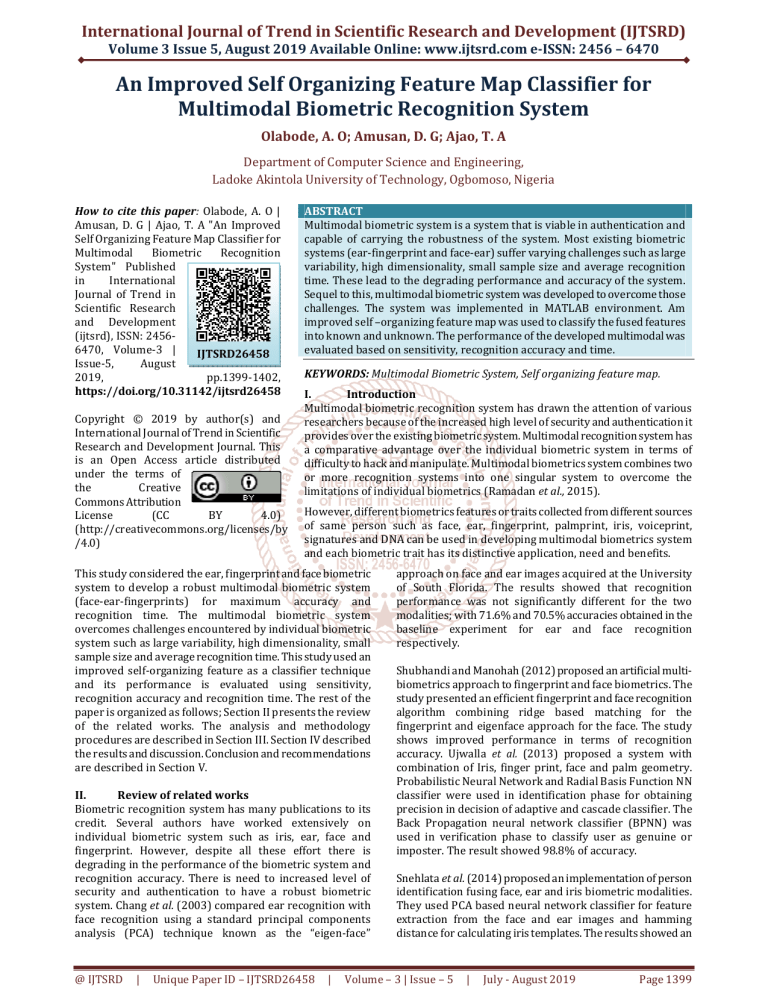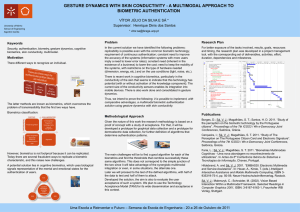
International Journal of Trend in Scientific Research and Development (IJTSRD)
Volume 3 Issue 5, August 2019 Available Online: www.ijtsrd.com e-ISSN: 2456 – 6470
An Improved Self Organizing Feature Map Classifier for
Multimodal Biometric Recognition System
Olabode, A. O; Amusan, D. G; Ajao, T. A
Department of Computer Science and Engineering,
Ladoke Akintola University of Technology, Ogbomoso, Nigeria
How to cite this paper: Olabode, A. O |
Amusan, D. G | Ajao, T. A "An Improved
Self Organizing Feature Map Classifier for
Multimodal
Biometric
Recognition
System" Published
in
International
Journal of Trend in
Scientific Research
and Development
(ijtsrd), ISSN: 24566470, Volume-3 |
IJTSRD26458
Issue-5,
August
2019,
pp.1399-1402,
https://doi.org/10.31142/ijtsrd26458
Copyright © 2019 by author(s) and
International Journal of Trend in Scientific
Research and Development Journal. This
is an Open Access article distributed
under the terms of
the
Creative
Commons Attribution
License
(CC
BY
4.0)
(http://creativecommons.org/licenses/by
/4.0)
ABSTRACT
Multimodal biometric system is a system that is viable in authentication and
capable of carrying the robustness of the system. Most existing biometric
systems (ear-fingerprint and face-ear) suffer varying challenges such as large
variability, high dimensionality, small sample size and average recognition
time. These lead to the degrading performance and accuracy of the system.
Sequel to this, multimodal biometric system was developed to overcome those
challenges. The system was implemented in MATLAB environment. Am
improved self –organizing feature map was used to classify the fused features
into known and unknown. The performance of the developed multimodal was
evaluated based on sensitivity, recognition accuracy and time.
KEYWORDS: Multimodal Biometric System, Self organizing feature map.
I.
Introduction
Multimodal biometric recognition system has drawn the attention of various
researchers because of the increased high level of security and authentication it
provides over the existing biometric system. Multimodal recognition system has
a comparative advantage over the individual biometric system in terms of
difficulty to hack and manipulate. Multimodal biometrics system combines two
or more recognition systems into one singular system to overcome the
limitations of individual biometrics (Ramadan et al., 2015).
However, different biometrics features or traits collected from different sources
of same person such as face, ear, fingerprint, palmprint, iris, voiceprint,
signatures and DNA can be used in developing multimodal biometrics system
and each biometric trait has its distinctive application, need and benefits.
This study considered the ear, fingerprint and face biometric
system to develop a robust multimodal biometric system
(face-ear-fingerprints) for maximum accuracy and
recognition time. The multimodal biometric system
overcomes challenges encountered by individual biometric
system such as large variability, high dimensionality, small
sample size and average recognition time. This study used an
improved self-organizing feature as a classifier technique
and its performance is evaluated using sensitivity,
recognition accuracy and recognition time. The rest of the
paper is organized as follows; Section II presents the review
of the related works. The analysis and methodology
procedures are described in Section III. Section IV described
the results and discussion. Conclusion and recommendations
are described in Section V.
II.
Review of related works
Biometric recognition system has many publications to its
credit. Several authors have worked extensively on
individual biometric system such as iris, ear, face and
fingerprint. However, despite all these effort there is
degrading in the performance of the biometric system and
recognition accuracy. There is need to increased level of
security and authentication to have a robust biometric
system. Chang et al. (2003) compared ear recognition with
face recognition using a standard principal components
analysis (PCA) technique known as the “eigen-face”
@ IJTSRD
|
Unique Paper ID – IJTSRD26458
|
approach on face and ear images acquired at the University
of South Florida. The results showed that recognition
performance was not significantly different for the two
modalities; with 71.6% and 70.5% accuracies obtained in the
baseline experiment for ear and face recognition
respectively.
Shubhandi and Manohah (2012) proposed an artificial multibiometrics approach to fingerprint and face biometrics. The
study presented an efficient fingerprint and face recognition
algorithm combining ridge based matching for the
fingerprint and eigenface approach for the face. The study
shows improved performance in terms of recognition
accuracy. Ujwalla et al. (2013) proposed a system with
combination of Iris, finger print, face and palm geometry.
Probabilistic Neural Network and Radial Basis Function NN
classifier were used in identification phase for obtaining
precision in decision of adaptive and cascade classifier. The
Back Propagation neural network classifier (BPNN) was
used in verification phase to classify user as genuine or
imposter. The result showed 98.8% of accuracy.
Snehlata et al. (2014) proposed an implementation of person
identification fusing face, ear and iris biometric modalities.
They used PCA based neural network classifier for feature
extraction from the face and ear images and hamming
distance for calculating iris templates. The results showed an
Volume – 3 | Issue – 5
|
July - August 2019
Page 1399
International Journal of Trend in Scientific Research and Development (IJTSRD) @ www.ijtsrd.com eISSN: 2456-6470
improvement over the existing result when the modalities
are combined, but the limitation is there was no separate
test with non-neutral data and also recognition time was not
reported. Ismaila et al. (2018) implemented unsupervised
learning algorithm in multi-modal biometric system that
made used of palmprint and thumbprint for its suitability.
The performance of the self-organizing feature map and
back-propagation neural network was evaluated and
compared. The back-propagation neural network produced
recognition accuracy rate of 93.7 while self-organizing
feature map yielded recognition accuracy rate of 93.5.
METHODOLOGY
III.
The developed multimodal biometric system was
implemented using MATLAB R2015a and run on Windows
10 professional 64-bit operating system, Intel(R) Core(TM)
i3-2370M CPU @ 2.40GHz, 4GB Random Access Memory and
500GB hard disk drive with accurate speed for better
performance of the developed system. The methodology
involved the acquisition of image datasets, the preprocessing
of the acquired images, the extraction of features, fusion of
the features and classification of the extracted features using
self-feature map.
Images acquisition
The face, ear and fingerprints of 120 subjects were captured
in the same lightening conditions with no illumination
changes in the size 1200 x 1600 pixels. Six images were
captured for 120 subjects with total dataset of 2160 images.
One thousand two hundred and sixty (1260) images were
used in training the system and the remaining 900 images
were used to test the system and finally saved in jpeg format.
Image preprocessing
Image pre-processing was carried out by converting face, ear
and fingerprint images into grayscale using histogram
equalization method. The average face, ear and fingerprint
vector were calculated and subtracted from the original
image vectors. This removed noise and other unwanted
element from the images. Each of the grayscale images are
expressed and stored in form of matrix in MATLAB which
eventually converted to vector images for further
processing.
Normalization removed any common features that all the
images shared together, so that each image was left with
unique features. The common features were discovered by
finding the average dataset vector of the whole training set
(face, ear and fingerprint images). Then, the average image
vector was subtracted from each of the dataset vectors
which resulted to normalized (face, ear and fingerprint)
vector using histogram equalization.
Feature extraction using principal component analysis
Principal component analysis was used for dimensionality
reduction by converting the set of correlated images into set
of uncorrelated eigenvectors. PCA eigenvector method
considered each pixel in an image as a separate dimension,
that is, N x N image has N2 pixels or N2 dimensions. To
calculate eigenvector, there was a need to calculate the
covariance metric for dimensional reduction. The
eigenvectors were sorted according to their corresponding
eigenvalues from high to low. The eigenvector
corresponding to zero, the eigenvalues were discarded while
those associated with non-zero eigenvalues were kept.
@ IJTSRD
|
Unique Paper ID – IJTSRD26458
|
Feature level Fusion
The feature set originated from three different sources (face,
ear and finger) were initially pre-processed and the
extracted features from each of the dataset formed a feature
vector. These features from each of the dataset were then
concatenated to form a new feature vector. Concatenation of
feature set increased the dimensionality of the fused feature
vector. Feature level fusion was used in this study because it
is can fuse incompatible feature vectors from multiple
modalities.
Training and testing of Multimodal Biometric System
using SOFM
The input vectors were presented to the network based on
the initial weights that was chosen at random and the
neuron with weights closest to the input image vector was
declared as the winner. Then, weights of all of the neurons in
the neighborhood of the winning neuron were adjusted by
an amount inversely proportional to the Euclidean distance.
During the training phase, the data acquisition, preprocessing, feature extraction process and feature
concatenation process took place concurrently and the fused
image sample was presented to the SOFM at a stretch. For
each node, the number of “wins” was recorded along with
the label of the input sample. The weight vectors for the
nodes were updated as described in the learning phase. By
the end of the stage, each node of the SOFM recorded t w o
values, that is, it generated the total number of winning
times for “known fused images” in image database, and the
total number of winning times for “unknown fused images”
in image database.
During the testing phase, SOFM classified individual image
based on correctly or incorrectly identified images. The fused
input vector was compared with all nodes of the SOFM and
the best match found based on minimum Euclidean
distance and was further subjected to some selected
threshold values such as 0.24, 0.35, 0.47 and 0.58. The
final output of the classified image was displayed as known or
unknown and the results were recorded as illustrated in
Figure 1.
The steps for Self-Organizing Feature Map algorithm
considered in this study were as follows;
1.
Each node's weights was initialized.
2.
A vector was chosen at random from the set of training
data and presented to the network.
3.
Every node in the network was examined to calculate
which ones' weights are most like the input vector. The
winning node is commonly known as the Best Matching
Unit (BMU).
4.
The radius of the neighborhood of the BMU was
calculated. This value started large. Typically it was set to
be the radius of the network, diminishing each time-step.
5.
Any nodes found within the radius of the BMU, calculated
in (iv.), was adjusted to make them more like the input
vector (Equation 2.17 and Equation 2.18). The closer a
node is to the BMU, the more its' weights are altered
(Equation 2.19).
6.
Repeat (ii) for N iterations.
Volume – 3 | Issue – 5
|
July - August 2019
Page 1400
International Journal of Trend in Scientific Research and Development (IJTSRD) @ www.ijtsrd.com eISSN: 2456-6470
Figure 1:Flowchart showing trained and tested of selected images with Self Organizing Feature Map
IV.
RESULTS AND DISCUSSION
The performance of multimodal system with respect to
SOFM was evaluated based on false positive rate, sensitivity,
specificity, recognition accuracy and recognition time. The
accuracy generated by SOFM was analyzed by using earfingerprint, face-fingerprints, face-ear and face-earfingerprints dataset features at different threshold values of
0.24, 0.35, 0.47 and 0.58 as illustrated in Tables 1-4. The
results obtained at different threshold values showed that
SOFM perform better at 0.58 threshold value than the rest of
the values. The results of the experiments with SOFM were
presented in Table1, Table 2, Table 3 and Table 4 based on
@ IJTSRD
|
Unique Paper ID – IJTSRD26458
|
false positive rate, sensitivity, specificity, recognition
accuracy and recognition time.
The recognition accuracy at multimodal level with SOFM
generated 94% of 0.24, 95% of 0.35, 96% of 0.47 and 97% of
0.58. The average recognition time produced at multimodal
level are 97.05s at 0.24, 92.10s at 0.35, 92.05 s at 0.47 and
91.60s at 0.58. In terms of false positive rate, SOFM
generated 8 at 0.24, 8 at 0.35, 6 at 0.47 and 4 at 0.58, while
sensitivity and specificity were on increase when subjected
to threshold values of 0.24, 0.35, 0.47 and 0.58.
Volume – 3 | Issue – 5
|
July - August 2019
Page 1401
International Journal of Trend in Scientific Research and Development (IJTSRD) @ www.ijtsrd.com eISSN: 2456-6470
Threshold
0.24
0.35
0.47
0.58
50
49
48
47
Threshold
0.24
0.35
0.47
0.58
Threshold
0.24
0.35
0.47
0.58
TP FP FN TN
0.24
0.35
0.47
0.58
0
1
2
3
45
45
47
47
TP FP FN TN
48
48
48
47
7
5
3
3
2
2
2
3
43
45
47
47
FPR
(%)
14
10
6
6
Table 2: FACE-FINGERPRINT
Sensitivity
Specificity (%)
(%)
96.00
86.00
96.00
90.00
96.00
94.00
94.00
94.00
Table 3: FACE-EAR
Sensitivity
Specificity (%)
(%)
96.00
86.00
94.00
88.00
92.00
92.00
92.00
90.00
Recognition Time
(Sec)
97.05
92.10
92.05
91.60
43
44
46
45
REFERENCES
[ 1 ] Chang , K., Bowyer, K. W., Sarkar, S., and Victor, B.
(2003). "Comparison and Combination of Ear and Face
Images in Appearance-based Biometrics," IEEE Trans.
Pattern Analysis and Machine Intelligence, vol. 25 pp.
1160-1165.
Ismaila W. Oladimeji, Shittu Jaleel K., Ismaila Folasade.
M, Ajayi Ayomide O, (2018): “Performance Evaluation Of
Unsupervised Learning Algorithm In Biometric Based
Fraud Prevention System” Journal of Engineering
Research and Application ISSN : 2248-9622 Vol. 8, Issue
10 (Part -I) Oct 2018, pp 62-67
@ IJTSRD
|
Recognition Time
(Sec)
95.05
92.90
91.15
91.30
Table 4: FACE-EAR-FINGERPRINT (MULTIMODAL LEVEL)
FPR
Sensitivity
Accuracy
TP FP FN TN
Specificity (%)
(%)
(%)
(%)
50
4 0 46
8
100.00
92.00
94.00
49
4 1 46
8
98.00
92.00
95.00
48
3 2 48
6
98.00
94.00
96.00
49
2 3 48
4
96.00
96.00
97.00
2
3
4
4
V.
CONCLUSION AND RECOMMENDATION
Am improved SOFM classified faster in terms of recognition
accuracy, recognition time, specificity and sensitivity for
multimodal biometric systems over the existing techniques
due to the fact that the images acquired were concatenated
into a single fused vector making it easier for classification.
This has contributed greatly in the areas of e-passports,
border control and e-learning. Future works can be carried
out by comparing and evaluate the performance of other
neural network techniques.
[2]
Accuracy
(%)
91.00
93.00
95.00
94.00
Recognition
Time (Sec)
98.20
92.85
92.20
91.00
Recognition Time
(Sec)
96.65
91.65
91.65
91.35
7
6
4
5
FPR
(%)
14
12
8
10
Accuracy
(%)
95.00
94.00
95.00
94.00
Accuracy
(%)
91.00
91.00
92.00
91.00
TP FP FN TN
48
47
46
46
Threshold
5
5
3
3
Table 1: EAR-FINGERPRINT
Sensitivity
FPR (%)
Specificity (%)
(%)
10
100.00
90.00
10
98.00
90.00
6
96.00
94.00
6
94.00
94.00
Unique Paper ID – IJTSRD26458
|
[3] Ramadan Gad, Ayman El-Sayed, Nawal El-Fishawy, M.
Zorkany, (2015): “Multi-Biometric Systems: A State
of the Art Survey and Research Directions” (IJACSA)
International
Journal of Advanced Computer
Science and Applications, Vol. 6, No. 6, pp.128–138.
[4] Shubhandi D. C. and Manohah (2012): BaliMultiBiometric Approaches to Face and Fingerprint
Biometrics: International Journal of Engineering
Research and Technology Vol. 1 Issue 5 ISSN: 22780181, July-2012.
[5]
Snehlata Barde, Zadgaonkar A. S, Sinha G. R. (2014),
“Multimodal Biometrics using Face, Ear and Iris
Modalities” International Journal of Computer
Applications, Recent Advances in Information
Technology. 21(5): pp. 0975 – 8887.
[6] Ujwalla Gawande and Kamal Hajari (2013)
“international Journal of Applied Information Systems”
(IJAIS) –ISSN: 2249-0868 Foundation of Computer
Science FCS, New York, USA Volume 6 –No.2,
September 2013–www.ijais.org
Volume – 3 | Issue – 5
|
July - August 2019
Page 1402





